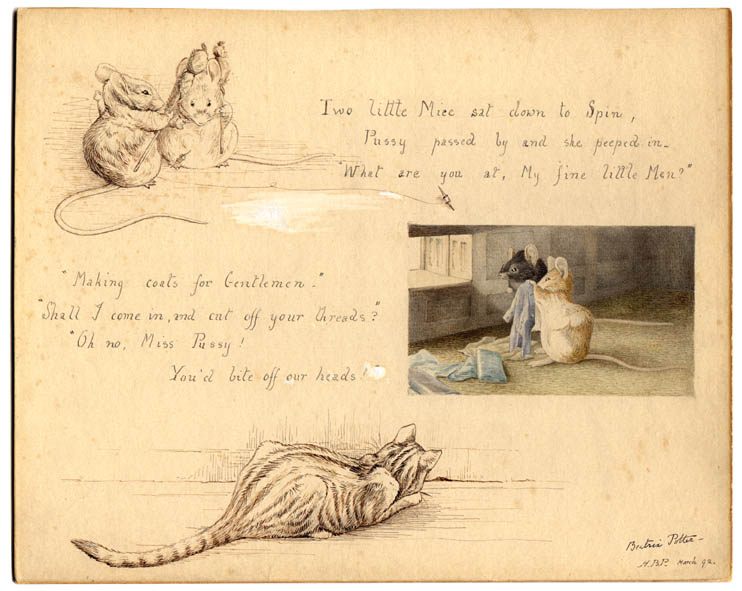Endicott Redux: The Real Miss Potter
En Endicott ya la comentan desde hace unos días, normal cuando ya llega la película que espero le haga justicia. La petit habla de ella, y más comodamente porque está en castellano.
Ahora les toca a los victorianos, cosa de la que me alegro profundamente y que te puedes imaginar si visitas Lavondyss de vez en cuando. Hemos tenido al Fauno, a los hermanos Grimm, al creador de Peter Pan, J. M. Barrie, y ahora; Lady Potter. (Que no tiene nada que ver con el niño ese de la varita). A ver cuánto tarda el Señor Lewis Carroll en aparece en escena.
Es bonito que se hable de ella porque tengo muchas latitas con sus dibujos aún hoy en las estanterías de mi cocina que me la recuerdan constantemente. Y por supuesto, en mi biblioteca tiene su sección. Lo que me recuerda que tengo que comprar ese dichoso deshumidificador porque la humedad, no perdona ni a Miss Potter.
Pero lo más importante es que Beatrix Potter trascendió con su ternura, su encanto y su arte, de ser una ilustradora de cuentos infantiles a convertirse en un estilo claramente definido, firma de una época, cuyos trabajos han ido atravesando las diferentes décadas hasta hoy mismo, soportando el paso del tiempo. Y que convive aún hoy con nosotros en pequeños rincones tal y como hacían sus ratoncitos, todavía regalándonos en la actualidad y por fortuna, sus Regiones Míticas.
The Real Miss Potter
When I heard that a film was being made about Beatrix Potter, it seemed like a terrific idea to me — for this famous children’s book writer (and early environmentalist) led a fascinating life. The finished film, Miss Potter, is a disappointment, alas…and Anthony Lane has nailed the reasons why in his wonderfully acerbic review in The New Yorker. The film, he says, «lapses, during the longueurs, into glorious views of the Lake District, without noticing that Potter herself, though steeped in the countryside…took care to parcel it out in tempting glimpses on the page, in the crannies of her industrious narratives. The hills and fells led her not into Wordsworthian rapture but into a social comedy as concise, and often as acidic, as Jane Austen’s.» (Read the full article here.)
If you’d like to know more about Beatrix Potter, forget the film and read Linda Lear’s engrossing new biography Beatrix Potter: A Life in Nature, which Elizabeth Hand has reviewed in The Washington Post. «At her death in 1943,» writes Hand, «the elderly Mrs. Heelis, nee Potter, left an estate valued at today’s equivalent of 7 million pounds — more than $13 million. Her influence on children’s literature is almost incalculable and can be seen in works by Alison Utley, Margaret Wise Brown, Tasha Tudor, Robert Lawson and Margery Sharp, to name just a few. Not bad for an empire built on what her editors called ‘the bunny book’.
«Yet Potter herself remains something of a mystery — not surprising, perhaps, for someone who for 16 years kept a diary written in code and whose work dealt almost exclusively with the doings of small creatures whose fictional lives and homes were cunningly hidden in hedgerows, wainscots, woodlands, farmsteads and floorboards.» (Read the full review here.)
Endicott Redux: The Real Miss Potter
Posted by Terri Windling





Razones superiores me impiden sentarme al ordenador más de unos minutos desde hace más de un mes, pero vengo a decirte cuánto echo de menos leerte.
Beatrix Potter forma parte de mis ídolos de infancia, junto a Edith Nesbit, y las dos han viajado a lo largo de mi vida conmigo.
Un abrazo
Gatopardo, espero seguir ofreciéndote cosas que te hagan soñar y hacerte sentir feliz. Te deseo lo mejor.
Cuídate mucho.
Con mucho afecto
Edanna